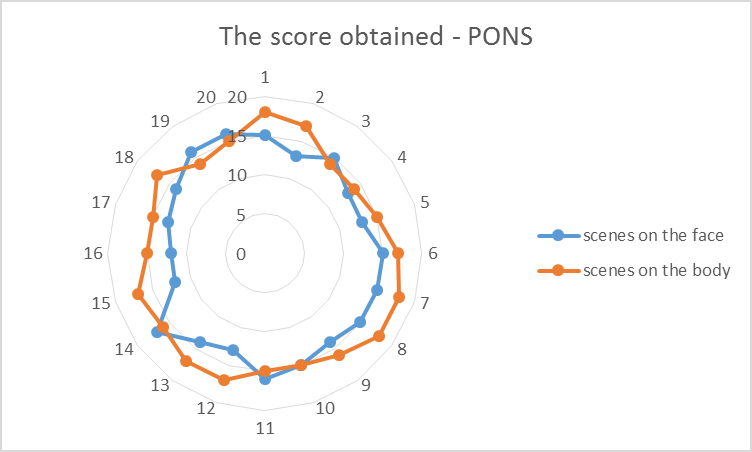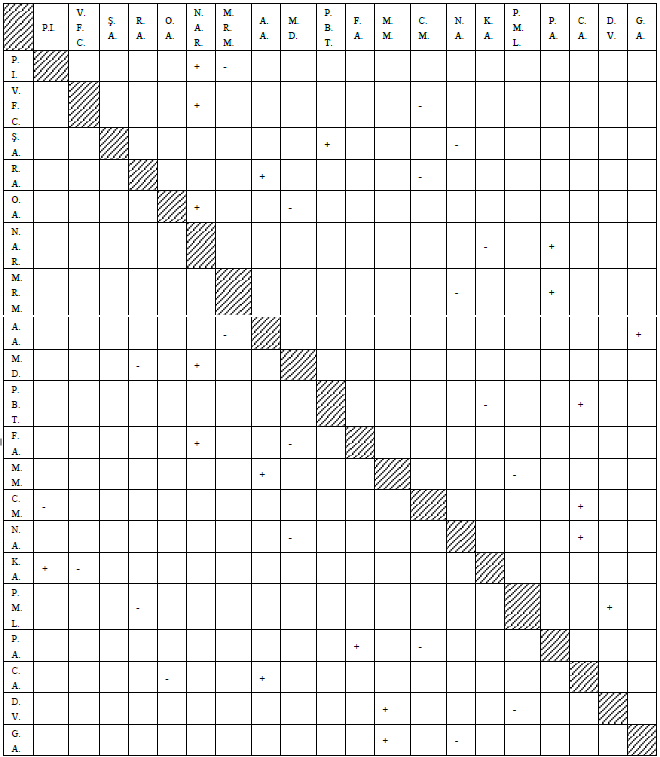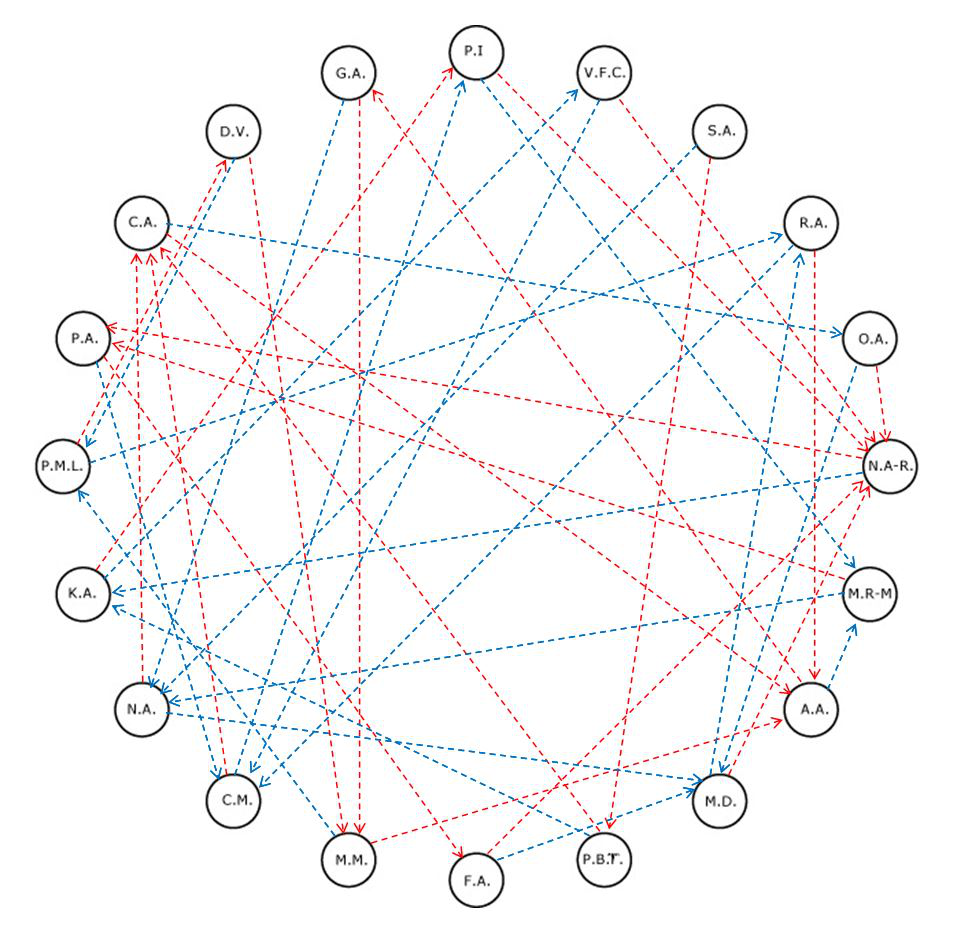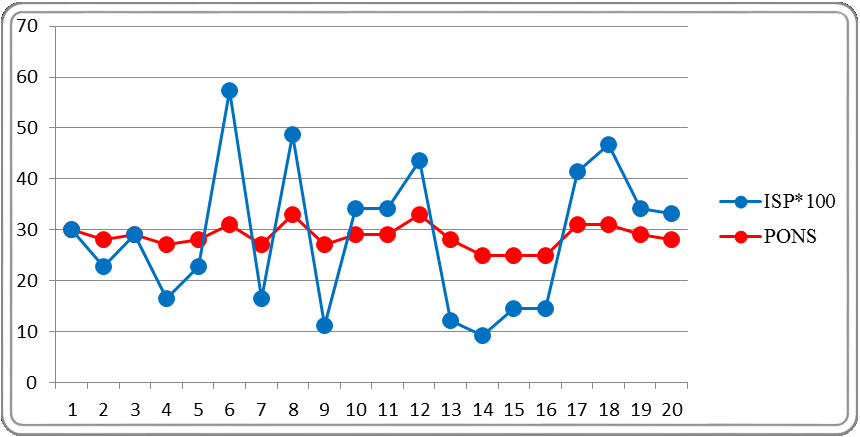Analysis of Nonverbal Communication Ability in Relation to Cohesion of the Representative Women’s Basketball Team – U16
Abstract
Basketball game involves, beyond physical preparation, the individual technical-tactical knowledge essential for the good development of the game, a proactive attitude towards the goal of the action or a “team spirit”. It consists in the interaction of players and is based on mutual knowledge, acceptance and understanding, on cooperation for reaching the common goal. The athletes’ ability to communicate and create relationships can be analysed in connection with the individual ability to shift attention, with the sociometric and preferential statuses, consequently with the team cohesion level. Sociometric analysis will be achieved periodically, according to the team structure, composition and evolution in order to ensure an optimal integration of athletes into the team, to increase its cohesion and eventually its performance. Sociometric analysis correlated to nonverbal communication ability, while knowing the preferential status indices (Psi), is the purpose of our research. The 20 subjects are members of the representative women’s basketball team, juniors U16. Nonverbal communication ability positively correlates with the preferential status index of the team player. Research methods: bibliographic study, PONS (Profile of Nonverbal Sensitivity) test, Moreno’s psycho-sociometric analysis, statistical and mathematical method, graphical representation. Average score obtained by calculating the Psi has a negative value, very close to zero, namely -0.000006. Regarding the minimal (-0.15) and maximal (0.26) values, it can be noted a balanced distribution of scores, as compared to central tendency. The value of Pearson’s correlation coefficient for PONS and Psi variables is rf = 0.833, which indicates a very close positive correlation between variables.
Keywords: Nonverbal communication, basketball, Moreno’s psycho-sociometric analysis
Introduction
Basketball is characterized by the game speed, the players’ task to play effectively on any position,
the fantasy of their technical-tactical execution, their team spirit and sacrifice, intelligence, nervous
resistance and creativity. Throughout the years, there have been developed different throwing, passing
and dribbling techniques, but also related to the positioning of players in the offensive and defensive
structures, as well as various communication forms/interrelations (Predescu & Ghițescu, 2001: 124). It
is important to know the type of nonverbal communication and the level where it occurs, in order to
increase efficiency of game actions particularly when emotions and state roles are significant, but also
for the situations where verbal communication is not reliable, is ambiguous (Preda, 2006: 74).
According to Shannon (quoted by Dragnea &Teodorescu-Mate, 2002: 158), “communication can be
defined as the transmission of a message from one point to another, from a source to a receiver’’,
where the source encodes the information and the receiver decodes it and has to understand the
language in which it is transmitted.
The sociometric status of players is another important element in the individual development
process, as well as in that of integration into the team, through the very influence the player exerts
voluntarily or not on the other teammates and the entire team.
Materials and methods
2.1. Hypothesis
Nonverbal communication ability positively correlates with the preferential status index of the team
player.
2.2. Research methods
This paper is an ascertaining pedagogical experiment and the research methods used were the
following: test method, graphical method, statistical and mathematical method with the statistical
parameters: percentages, Pearson’s correlation coefficient (r) (Popa, 2008: 163).
2.3. Period, location and subjects of the research
The experiment tested the members of the Romanian representative women’s basketball team, with
ages between 15 and 16 years. Testing was conducted on 8 May 2013 at the Olympia Sports Hall.
2.4. Tests used
It was applied a nonverbal communication test, PONS (Profile of Nonverbal Sensitivity) N.
Ambady 1980, translated and adapted by Loredana Ivan (the only scale of cultural and linguistic
competences). The test assesses the ability to decode nonverbal signals of the face and body (facial
expressions, gestures, looks, touches, vocal clues), used to transmit dynamic nonverbal messages. This
involves applying a questionnaire for the correct identification of 40 nonverbal scenes after watching a
movie. Out of the 40 nonverbal scenes, 20 provide clues situated at the face level, and 20, at the body
level (positions of arms and body). The scenes are displayed on a screen every 6 seconds, for the
duration of 3 seconds. In the 3-second break between scenes, the athlete must write on a sheet of paper
the response related to the nonverbal message transmitted in the respective scene. For each message
identified, 1 point will be granted. The values according to which the nonverbal competence level will
be established are: below 20 points obtained - low nonverbal competence, between 20 and 25 points
obtained - average nonverbal competence, above 25 points obtained - high nonverbal competence.
proposed for the first time in 1934 by the Romanian-born
American psycho-sociologist Moreno, the sociometric method involves a set of procedures,
experimental and mathematical techniques intended to measure the configuration, intensity and extent
of psychological affective substructures that arise within social micro-groups. It aims to highlight the
informal dimensions of group life, the sympathetic interrelations spontaneously created between the
group members, the sets of behavioural norms generated in the process of direct interaction between
individuals, recognized and accepted as such by each group member, without external constraints.
Through this instrument, it is made an attempt to study the group structures in terms of psychological
factors, especially the attractions and rejections manifested within the group.
Results
Table 1 shows the results obtained by the girl athletes assessed using PONS test, and from their
analysis, it can be noticed that in all cases the score exceeds 25 points, which places nonverbal
competence at a high level.

Figure 1 illustrates the distribution of scores obtained for the two categories of emotional situations/
scenes (at the face level and the body level). It can be noted that, in 70% of cases (14 situations), the
results achieved for the category of scenes situated at the body level are superior to the scores achieved
for the category of scenes situated at the face level; this finding can be argued by the fact that, during
the basketball game, players’ attention is primarily oriented towards the movement on the playing field,
the body attitude and the travel intention of teammates and opponents, rather than on their facial
expressions and the manifestation of their emotional feelings.

Selection and peer-review under responsibility of the Organizing Committee of the conference
To assess the team cohesion level and calculate the status indices (Moreno’s sociometric analysis),
the players were given a sheet of paper containing four questions and were asked to give honest
responses, without subjectivity. The girls had to name the teammates they preferred, those they did not
prefer, the teammates who, in their opinion, preferred them, and those who, in their opinion, did not
prefer them. They were asked to relate their preferential responses to the game situations, without
considering the professional affinities and non-athletic circumstances. For the first 2 questions, 3
response options were made available and they had to order them according to preferential intensity.
For the other 2 questions, 1 single response was deemed sufficient. Sociometric matrix (Table 2) was
drawn by synthetizing the primary preferences under the form of elections (marked by the sign “+”)
and rejections (marked by the sign “-”).

The next level of sociometric analysis is the interpersonal one, of the socio-affective relations
created within the group. The sociogram was drawn to illustrate intuitively the momentary
configuration of the socio-affective group structure, the extent to which the election or rejection
relations expressed by the girl athletes were unilateral or mutual. The balance of sociometric powers is
schematized in Figure 2; positive elections (attractions) are represented by dotted red arrows, negative
elections (rejections) are represented by dotted blue arrows, and mutual elections are represented by
arrows with solid line, red for the attractions and blue for the rejections. In the group assessed by us,
there are no mutual relations, either of attraction or rejection, which shows that the group dynamics is
not strong and the power of influence and interaction is low.

Preferential status index represents the difference between the number of elections received and the
number of rejections received, related to the total number of individuals in the group, respectively to
the team total minus 1, taking into account that a person may not elect himself/herself. To analyse the
relation between the two variables, namely communication ability and preferential status index, we
have constructed Figure 3, which shows the common tendency of the two lines to change directions.

To validate the hypothesis, according to which the two variables (nonverbal competence and
preferential status index) vary in direct proportion, it is necessary to calculate statistically a correlation
indicator. Given the size of the group, we considered it appropriate to calculate Pearson’s correlation
coefficient (marked by an “r” in statistics). Pearson’s correlation coefficient r = 0.833 (Table 3) shows
a strong association between the two variables.
Discussions and conclusions
Knowing and mastering the communication process during the basketball game is an essential
element for directing the team, the interrelations existing within the groups of players, and for building
the game tactics; It is important to know the type of nonverbal communication and the level where it occurs, in order
to increase efficiency of game actions particularly when emotions and state roles are significant, but
also for the situations where verbal communication is not reliable, is ambiguous;
When verbal communication is inefficient because of environmental factors or any other barriers of
language, nonverbal competence is definitely beneficial for the interaction of players within the team
and for achieving the proposed goal;
Nonverbal communication ability can represent a criterion for player assessment. A player with a
high level of nonverbal competence, if put in a key-position, will succeed in mediating the entire
communication process necessary to carry out the specific technical-tactical action; this aspect and the
strong association with the preferential status index lead to the idea that, by intervening positively on
any of the variables, we shall manage to produce changes in the same direction over the other;
Pearson’s correlation coefficient r = 0.833 indicates a strong association between the two variables,
validating the hypothesis according to which nonverbal communication ability positively correlates
with the preferential status index of the team player – The hypothesis is confirmed.
Acknowledgements
Data presented in this paper are part of the doctoral thesis “The role of nonverbal and verbal
communication in increasing performance efficiency of junior cadet basketball teams - U16”. We want
to thank the Romanian Basketball Federation for the support granted to achieve this research.
References
Dragnea, A., & Teodorescu-Mate, S. (2002). Teoria sportului. Bucureşti: FEST.
Popa, M. (2008). Statistică pentru psihologie - Teorie şi aplicaţii în SPSS. Iaşi: Polirom.
Preda, M. (2006). Comportamentul organizațional. Iaşi: Polirom.
Predescu, T., & Ghiţescu, G. (2001). Baschet. Pregătirea echipelor de performanţă. Bucureşti: Semne.
Copyright information

This work is licensed under a Creative Commons Attribution-NonCommercial-NoDerivatives 4.0 International License.
About this article
Publication Date
10 June 2016
Article Doi
eBook ISBN
978-1-80296-010-5
Publisher
Future Academy
Volume
11
Print ISBN (optional)
-
Edition Number
1st Edition
Pages
1-509
Subjects
Sports, sport science, physical education
Cite this article as:
Marinescu, G., Moanța, A. D., Zamfir, M. V., & Ticala, L. D. (2016). Analysis of Nonverbal Communication Ability in Relation to Cohesion of the Representative Women’s Basketball Team – U16. In V. Grigore, M. Stanescu, & M. Paunescu (Eds.), Physical Education, Sport and Kinetotherapy - ICPESK 2015, vol 11. European Proceedings of Social and Behavioural Sciences (pp. 82-89). Future Academy. https://doi.org/10.15405/epsbs.2016.06.12

